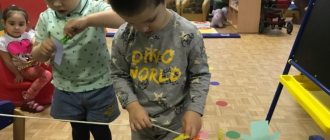How to create an activity at home?
The main principles of homework:
- Regularity. Exercise every day, but without overloading the baby and taking into account his age and well-being. You can start with 3-5 minutes a day, gradually increasing to 15-25.
- Game form. Only you know what your child will like most: retelling an interesting story or a competition to see who can pronounce a tongue twister the fastest. Start with tasks that are more interesting to your baby, gradually moving on to less exciting ones.
- Comfortable environment. For many types of activities you need, at a minimum, a table, a comfortable chair, and often a mirror on a stand.
- Patience. It is impossible to achieve amazing results in one mini-lesson. Encourage your child, praise him for successes and don’t get angry for mistakes, don’t laugh or imitate. Otherwise, the baby will withdraw into himself, and speech problems may worsen.
- Do not do tasks for your child if he cannot cope with them. The point of the classes is to benefit the baby, and not to impress the speech therapist.
Creating a developmental environment
In order for a child’s speech to develop, it is necessary to create favorable conditions for this. The most important thing is to talk to the child as much as possible, because speech is based on imitation - repeating words and phrases after an adult. Speech should constantly surround the baby; he should “bathe” in speech. To do this, the adult comments on all everyday situations, routine moments and other events in the baby’s life.
For example, washing: “Let’s go wash. Let's open the tap. No, not this way, the other way. Like this. Where's the soap? Here's the soap. Take soap and wash your hands. Put the soap in the soap dish. Let me help you. Three hands good. Now let's wash off the soap. Place your hands under the water - like this. Now let's wash our face. Take water into your palms and rub your face. Close the tap. Now let's shake the water off our hands - like this. Where's the towel? Take a towel and dry your face and hands. Well done! Look how clean it has become.”
Perhaps such a constant conversation with the baby will initially cause some difficulties for adults and will require a change in communication style and behavior. But as experience shows, this is a matter of training: if there is a desire and enough persistence, then an adult can, over time, learn to communicate with the baby more constructively from the point of view of the child’s speech development. At the same time, with experience comes a “sense of balance”: you need to speak constantly, but at the same time not overdo it and not be too verbose, speak with normal volume, simple phrases and only to the point.
Pronunciation of complex sounds
Articulation develops gradually; children usually master the pronunciation of complex sounds last. Often in speech the child replaces them with simpler ones or does not pronounce them at all.
Sound "R"
Experts advise studying this difficult sound in a child at the age of 5. If the baby pronounces “r”, but incorrectly, then even earlier - then it’s more difficult to relearn.
To help:
- Tongue twisters with “r” (“Karl stole corals from Clara, and Clara stole Karl’s clarinet.”
- Imitation (just say “r” in your speech in front of the child as clearly and cleanly as possible).
- Production from other sounds that the child pronounces correctly. For example, when a child pronounces “zh”, carefully move the tongue deeper into the mouth with a stick - a “r” is formed. Strengthen the sound by repeating the exercise several times. Or the baby says “z”, lightly touching the alveoli with his tongue, and blows heavily on the tongue. The sound "r" is heard.
- Three-stage exercise: the tongue is “sucked” to the hard palate, the child takes a deep breath through the nose and a short exhale through the mouth, connecting the voice.
- Setting up mechanically (carried out only by a speech therapist - with a hammer, spatula).
Sound "Sh"
The production of this sound occurs at 3–5 years of age.
The most commonly used way is through “s”. The child raises his tongue to the sky, pronounces “s” and smoothly exhales air to make “sh”. Before directly placing the “w,” experts recommend developing articulation of the lips and tongue with the help of exercises:
- A wide smile, exposing both rows of teeth, for 5-7 seconds.
- Licking lips with a “wide tongue” from top to bottom.
- Curling the wide tip of the tongue towards the nose.
- The child stretches out his lips with a straw and blows on a cotton ball for a long time, pushing it, for example, into the corner of the table.
- The baby blows through his closed lips onto a strip of paper - stronger, weaker, stronger again.
Fun ABC lesson
This group of games helps children learn a lot of new things from the life of words, expand their vocabulary, and knowledge about language.
Ball game "Say the opposite."
Winter summer. Heat - cold. True False. Rich man - poor man. Bitter - sweet. Useful - harmful...
"The Magic Wand of the Fairy Slovarina"
To play you need a “magic” wand. One end of the stick decreases, and the other increases.
An adult player names a word, then touches one of the children with a stick. The child calls this word either diminutive or increasing, depending on the end of the stick with which the child was touched.
House - house - house. Bridge - bridge - bridge. Rain - rain - rain. Cat - cat - cat...
Author: Krugovykh Margarita Aleksandrovna
Senior teacher of MADOU d/s No. 7 in Ishim
Everyone knows what an important function breathing performs in the life of the human body. In addition to its main physiological function - gas exchange - breathing also provides such a function as speech breathing. Speech breathing (diaphragmatic) is the basis of sounding speech, the source of the formation of sounds and voices.
The mechanism of this type of breathing is inherent in us from the very beginning. This is the oldest type of breathing, inherent in all warm-blooded animals and 90% of the total need for breathing is carried out due to it.
The main muscle that powers this type of breathing is the diaphragm . It separates the abdominal and thoracic cavities. When you inhale, the diaphragm relaxes and, falling, presses on the abdominal organs, which in turn are pressed against the abdominal wall, causing it to protrude and round. As you exhale, the diaphragm contracts, compresses the lungs, and the abdominal wall retracts. In this case, the upper part of the chest remains motionless. Outwardly, it looks like belly breathing.
When correcting speech disorders, there is a need to specially organize and develop speech breathing; breathing exercises become of particular importance. The corresponding gymnastics is aimed at developing in children the skills of correct rational breathing and voluntary control of the process of air flow movement.



